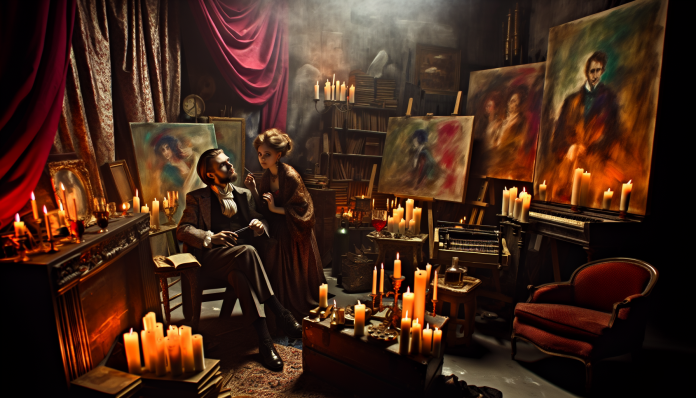Introduction
Egon Schiele, the Austrian painter known for his raw and provocative artwork, not only captured the zeitgeist of early 20th-century Vienna but also left a significant mark on the realms of scandal and sexuality. His sensual paintings, characterized by distorted forms and exaggerated emotionality, often explored themes of desire, eroticism, and personal freedom. But Schiele’s life off the canvas was just as tumultuous as the figures he portrayed. A series of affairs and contentious legal battles surrounded him, forever intertwining his artistic genius with social scandal.
Living during a time when societal norms around sex and relationships were rigidly conservative, Schiele’s unfiltered expressions of human sexuality brought him both acclaim and controversy. Let’s delve into the scandal of his life and work, examining not just the shocking nature of his art and affairs but also how these realities reflect shifting cultural understandings of sex and morality then and now.
The Scandal
A Brief Overview of Schiele’s Life
Egon Schiele was born in 1890 in Tulln, Austria. His artistic breakthrough came in 1909 when he became a member of the Vienna Secession, a movement that sought to push artistic boundaries and challenge traditional norms. His often bleak and erotic portraits, alongside a fascination with sexuality and death, caught both admiration and condemnation.
However, it was Schiele’s personal life that would lead to substantial public outcry. He was known for having numerous affairs, typically involving young models, some of whom were minors. These relationships often blurred the lines of legality and morality at the time.
The Notorious Legal Battle
The most significant scandal ignited when Schiele was arrested in 1912 on charges of seduction and abducting a young girl named Wally Neuzil. At the heart of the controversy were not only the allegations but also Schiele’s unapologetic sexual expression, documented through both his artwork and his lifestyle.
- The Arrest: Schiele was taken into custody after Wally’s mother accused him of having seduced her 16-year-old daughter. While the young woman had posed for many of Schiele’s paintings, it was suggested that the relationship extended beyond art. In his defense, Schiele asserted that they were merely companions, although his extensive collection of sensuous drawings certainly painted a different picture.
- Public Reaction: The arrest ignited a media frenzy. Schiele symbolized societal taboos around sexuality, particularly when involving minors. Many criticized him, labeling him a predator, while others defended his artistic merit arguing that his exploration of eroticism reflected broader human experiences.
The Testimony and Aftermath
Though Schiele was sentenced to a mere 24 days in jail, the damage was done. His reputation had been compromised, and many of his contemporaries distanced themselves from him. His arrest did not end his creative output; if anything, it intensified his work. Post-incarceration, Schiele produced some of his most powerful pieces, echoing themes of vulnerability and transgression.
Moral and Cultural Analysis
Societal Reactions Then
When Schiele fell from grace, public sentiment was dominated by a hyper-focus on morality. The early 1900s in Vienna was a period rife with repressed sexuality, wherein discussions about eroticism were largely taboo.
-
The Gender Divide: Women’s roles were confined to domesticity, and any divergence from that norm was highly scrutinized. Schiele’s relationships conveyed a transgressive nature, challenging the status quo. The societal uproar reflected fears about unsettling traditional gender roles and sexuality.
- Censorship: His struggles with the law led to a form of artistic censorship. Many galleries hesitated to exhibit his work, fearing backlash from the public and authorities. The controversy surrounding him and his work represented wider societal anxieties about human desire and expression.
Contemporary Perspectives
Fast forward over a century, and many of the norms that shaped Schiele’s life have dramatically evolved. Today, what once might have been a scandal could be contextualized differently within modern liberal values.
- Art versus Morality: In contemporary society, Schiele’s work might be viewed through a lens of personal freedom and artistic expression. A modern audience might praise his boldness in exploring complex human themes, while possibly condemning his relationships with minors from a legal perspective.
- Gender and Power: Today’s discussions about power dynamics in relationships, particularly those involving significant age differences and consent, require nuanced interpretations that reflect changing values about autonomy and agency.
Conclusion
Egon Schiele’s life and art serve as a fascinating case study in the evolving conversation about sexuality and societal norms. His unapologetic embrace of desire revealed fundamental truths about human nature that resonate across time.
This scandal, which once marred his reputation, now invites contemplation about how sexuality is perceived, how power dynamics operate in relationships, and the ongoing struggle for personal freedom in artistic expressions. Schiele’s legacy challenges us to reflect: as society progresses, what can be gleaned from our past scandals, and how can we shape the way we engage with art, love, and desire moving forward?
As we navigate our own culture’s understandings of morality and personal freedom, let us draw lessons from the past, critically engaging with history to influence our contemporary views on sex, art, and human relationships. Schiele might have faced condemnation in his time, but today, he also prompts us to question, to explore, and, perhaps, to defy societal boundaries in the quest for understanding ourselves and each other.

